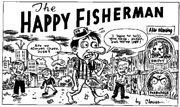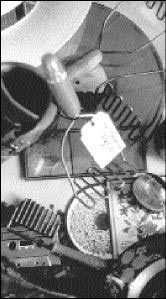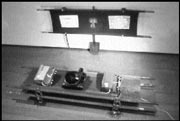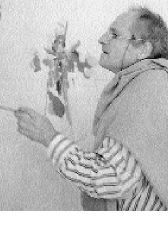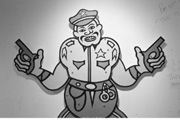DAN CLOWES AND CHRIS WARE
Roq La Rue Gallery, 2224 Second, 374-8977 Opening party 6-10 p.m. Fri., May 11; show runs May 11-June 10
JIMMY CORRIGAN IS GOING nowhere fast. A pudgy, middle-aged doormat who relies on complacency instead of ambition, his primary occupation is getting bossed around by his mother. Lonely and inarticulate, he’s embarrassed by the slightest reference to any kind of emotion or physicality. In short, he’s the quintessential sad sack. The frames of Corrigan’s comic-book life are filled with his wordless worry, stammering responses, and blank stares.
Yet he’s the hero—or anti-hero—of Chris Ware’s popular comic series (and now 380-page book, both eerily reminiscent of Ware’s own life) Jimmy Corrigan: The Smartest Kid on Earth (Pantheon, $27.50). At the prow of the alternative-comic genre, Ware and Dan Clowes are considered by some to be two of the best graphic artists of their generation. Without really trying, they are also pioneers in the genre of graphic literature, a variety of comic that has been legitimized by intellectuals. Whereas the comic book has traditionally resided on the outskirts of artistic and literary production, with undeniable ties to both but no secure foothold in either camp, so-called “graphic literature” exists at the very intersection of literature and art.
The comic heroes created by Dan Clowes (he did the poster for the movie Happiness) are equally removed from the superhuman or postapocalyptic characters that populate mainstream comic books. Clowes focuses on regular folks (similar to Ware’s underdog protagonist), dwelling on their internal lives and introversions, rather than on plot- or action-driven sequences. His series Ghost World (recently made into a feature motion picture) revolves around two ironic and unflaggingly cynical teenage girls, Enid Coleslaw and Rebecca Doppelmeyer. Like Corrigan, Enid and Rebecca seem to be extensions of Clowes’ own personality—alter egos who live out exaggerated versions of the artist’s psyche, self-esteem, and paranoia. Clowes has even remarked that it feels safe to say anything he wants through the girls’ voices; this, he says, is a liberating experience because teenage girls are “allowed to struggle to define themselves and to overreact to everything in a way the rest of us aren’t.”
IT WOULD BE a stretch to say that either artist’s works are literary or artistic masterpieces. Rather, they’re the combination of the two realms—the dark, introverted narratives complemented by both artists’ meticulous graphic styles that carry these works to new literary and aesthetic heights. Ironically, in most mainstream comics, the storyline takes a backseat to the visuals. But in Ware’s and Clowes’ hypercontrolled work—which borrows precision, architectural exactitude, and clean, hard lines from the cartoon strips of the 1940s, ’50s, and ’60s—the art seems secondary to their twisted worldview and dark humor. The stories, in turn, infuse the art with the edge it requires to wind up on a gallery’s walls.
Ware resists the critic’s impulse to scrutinize his work as fine art or literature, preferring to glory in the freedom that his lowbrow, proletariat form of expression affords him. “When people look at a painting and they don’t like it,” he says, “they assume that they didn’t understand it. But if someone reads a comic strip and they don’t like it, they say it’s a lousy comic strip. That’s a great advantage to comics as an art form.” True enough. But hang anything in a gallery and you’re setting yourself up. While neither the art nor the narratives may stand alone, together they create compelling, funny, and even heart-wrenching works.
